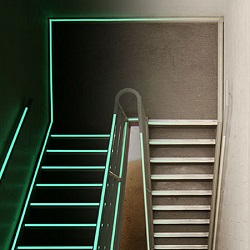









Ensuring accessible egress routes during emergencies is paramount. This blog discusses how code-compliant signage helps guide all occupants, especially those with disabilities, to safety in evacuations.
As an inclusive nation, Canada enforces stringent accessibility laws through the National Building Code (NBC) and provincial building codes. These regulations mandate universally accessible evacuation routes to protect human life above all.
NBC Chapter 3 thoroughly outlines exit sign requirements to aid visibility-impaired individuals effectively. Besides conventional exit signs, it explicitly requires:
Photoluminescent signs are illuminated without any electrical power.
Tactile cues along entire exit paths denoting hazards or directional changes.
Sign placement considering vision and cognitive impairments as per universal design principles.
Failure to comply can result in hefty penalties or liability lawsuits if an incident occurs due to inadequate signage. It emphasizes the critical need for code-certified solutions.
Integrating tactile and photoluminescent systems creates optimally accessible egress routes. While tactile products, like truncated dome tiles, aid those with vision loss, photoluminescent signs benefit all during outages. Here are some synergistic solutions:
Ecoglo photoluminescent signs, tested to AODA/NBC, help non-disabled evacuate power outages safely.
AccessTile dome tiles and bars caution about exit pathway hazards even without visibility.
ArmorTile directional bars and domes safely guide disabled occupants along designated routes.
ElanTile's porcelain tiles with domes and bars withstand decades of use while exceeding tactile standards.
Partnering suppliers ensure that specifying code-certified products meets unique facility needs and foot traffic intensities.
Proper installation boosts signage lifespan and performance. Consider:
Mount photoluminescent signs 1.8-2.4m above the floor as per codes.
Fasten signs securely with tamper-proof hardware suitable for indoor/outdoor conditions.
Align tactile products flush along entire designated paths without gaps disrupting the flow.
Adhere to manufacturers' specified substrate preparation and placement guidance.
Use third-party inspectors post-install to ensure code compliance before occupancy.
Partnering with an experienced accessibility solutions provider streamlines compliant installations for hassle-free execution and adherence to prescribed techniques.
Photoluminescent exit signs provide critical illumination without electricity. Some key benefits:
Remain visible independently for 70+ hours after just 1 hour of 54 lux light exposure.
Store and gradually emit ambient light using day-charging technology to guide evacuations safely during emergencies like power outages caused by fires.
Exceed code specifications for luminance levels and glow-duration, outperforming battery-powered options over the long run.
Weatherproof, corrosion-resistant designs make them suitable for both indoor and outdoor use without covers or additional protections.
The lower total cost of ownership versus traditional LED exit signs needing frequent battery replacements.
Their unparalleled reliability and minimum maintenance requirements aid quick, orderly evacuations from all facilities.
Properly placed tactile systems are invaluable accessibility aids, particularly during emergencies:
Truncated dome tiles serve as critical hazard indicators, like notifying abrupt floor changes.
Parallel bar textures safely delineate designated evacuation paths for disabled individuals.
Canes cannot detect subtle cues like directional arrows, making tactility imperative for guiding visually impaired evacuees.
Raised tiles provide orientation even in total darkness when vision is obscured by smoke during emergencies.
Regularly inspect and promptly replace aging, damaged tactile solutions to maintain unobstructed navigation.
Investing in code-compliant signage reassures evacuation preparedness for people with disabilities.
Some top manufacturers supplying synergistic solutions for safe, inclusive evacuation guidance include:
Ecoglo - Premium photoluminescent exit signs, stairs, and path markers independently tested to AODA and NBC standards.
AccessTile - Advanced polymer composite truncated domes and directional bars for cast or surface applications.
ArmorTile - Heavy-duty detectable warning tactile tiles engineered to withstand decades of use.
ElanTile - High-end porcelain tactile indicators combining elegance with exceptional longevity.
AdvantageOne - Specialized metal domes and bars meeting compliance needs of large infrastructure projects.
Consult accessibility experts to specify ideal products aligning with your facilities' unique spatial requirements and foot traffic volumes.
Proactively implementing code-certified signage reassures dependable evacuation from unforeseen emergencies for people of all abilities. Tactile Solution Canada is committed to supplying trusted, rigorously tested solutions for effortless compliance.
A. Each exit level needs illuminated EXIT signs and directional indicators as per NBC/OBC. Photoluminescent exit signs must glow for a minimum of 60 minutes without power as well.
A. Outsource specialized inspections to experts and replace non-compliant solutions. Also, work with suppliers offering installation, budget plans, and preventative maintenance contracts.
A. While NBC/OBC guidelines differ slightly, photoluminescent signs certified to applicable codes can be safely used indoors or outdoors without additional coverings due to weatherproof, durable, luminous pigments.
